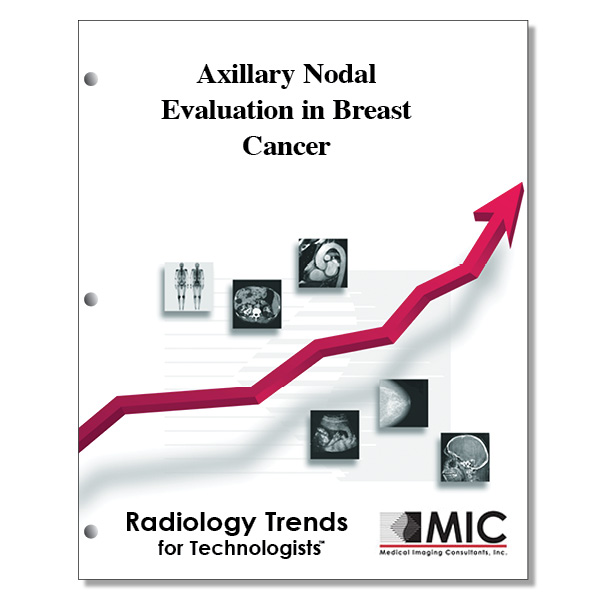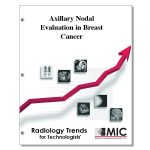

Axillary Nodal Evaluation in Breast Cancer
A review of updated evidence for axillary nodal evaluation before treatment and following neoadjuvant chemotherapy, focussing on the roles of axillary imaging to guide axillary management for invasive breast cancer.
Course ID: Q00636 Category: Radiology Trends for Technologists Modalities: CT, Mammography, MRI, Nuclear Medicine, Radiation Therapy, Sonography3.0 |
Satisfaction Guarantee |
$34.00
- Targeted CE
- Outline
- Objectives
Targeted CE per ARRT’s Discipline, Category, and Subcategory classification:
[Note: Discipline-specific Targeted CE credits may be less than the total Category A credits approved for this course.]
Breast Sonography: 3.00
Patient Care: 0.50
Patient Interactions and Management: 0.50
Procedures: 2.50
Pathology: 2.00
Breast Interventions: 0.50
Mammography: 3.00
Patient Care: 0.50
Patient Interactions and Management: 0.50
Procedures: 2.50
Anatomy, Physiology, and Pathology: 1.00
Mammographic Positioning, Special Needs, and Imaging Procedures: 1.50
Magnetic Resonance Imaging: 3.00
Patient Care: 0.50
Patient Interactions and Management: 0.50
Procedures: 2.50
Body: 2.50
Nuclear Medicine Technology: 3.00
Patient Care: 0.50
Patient Interactions and Management: 0.50
Procedures: 2.50
Other Imaging Procedures: 2.50
Registered Radiologist Assistant: 3.00
Procedures: 3.00
Thoracic Section: 3.00
Sonography: 3.00
Patient Care: 0.50
Patient Interactions and Management: 0.50
Procedures: 2.50
Superficial Structures and Other Sonographic Procedures: 2.50
Radiation Therapy: 2.00
Patient Care: 0.50
Patient and Medical Record Management: 0.50
Procedures: 1.50
Treatment Sites and Tumors: 1.00
Treatments: 0.50
Outline
- Introduction
- Imaging Modalities for Axillary Node Staging
- Mammography
- US Examination
- US-Guided Needle Biopsy
- Breast MRI
- Chest CT or PET/CT
- Pretreatment Axillary Node Evaluation
- Controversy Regarding the Need for Routine Preoperative Axillary US
- Assessment and Prediction of Preoperative Axillary Node Disease Burden
- Axillary Node Evaluation Following NAC
- SLNB in Clinically Node-Positive Cancer Treated with NAC
- Axillary US with LN Marking for Targeted Axillary Dissection
- Role of Axilla Imaging in Prediction of pCR after NAC
- Future of Axillary Imaging
- Conclusion
Objectives
Upon completion of this course, students will:
- list the determinates for pathologic staging of breast cancer
- state the most important predictor of overall recurrence and survival of breast cancer patients
- state the 5-year survival rate for patient with breast cancer localized to the breast
- describe how nodal status affects breast cancer care
- recall the standard surgical approach to axillary staging in patients with clinically node-negative breast cancer
- define low tumor burden
- describe imaging modalities best utilized for specific patient populations in order to offer the patient a less-invasive approach to care
- define clinically suspicious nodes
- describe axillary imaging levels
- choose the best imaging modality for assessment of axillary nodes
- recall the percent of axillary level 1 lymph nodes that are visible at routine mammography
- describe the appearance of normal axillary lymph nodes at mammography
- describe the appearance of a normal axillary lymph node at ultrasound
- list sonographic features that can predict extranodal extension
- choose the imaging modality useful for identifying nonhilar peripheral blood flow in metastatic lymph nodes
- list the advantages of fine-needle aspiration biopsy
- describe typical morphologic features that can be seen with metastasis at magnetic resonance imaging
- list the regions at computed tomography where soft tissue masses can suggest metastatic lymph nodes in patients with known breast cancer
- state what radiopharmaceutical is utilized in breast positron emission tomography
- state the modalities used for evaluating therapy response following NAC
- describe the role of ultrasound and ultrasound-guided biopsy in preoperative identification of axillary metastases
- list the agencies that still advocate preoperative axillary ultrasound in patients diagnosed with breast cancer
- choose the study from Table 2 in the text that utilized both ultrasound and magnetic resonance imaging to evaluate axillary nodal disease burden
- list the most widely used models developed to predict metastasis involving nonsentinel lymph nodes
- list the scoring systems utilized to assess axillary nodal disease burden
- list the clinical-pathologic information utilized in the models for assessment of axillary nodal disease burden
- choose the study that created a nomogram with preoperative ultrasound findings and chest CT of the axilla to predict three or more axillary lymph nodes in women who met the Z0011 criteria
- choose the study that included preoperative axillary ultrasound in addition to clinical-pathologic characteristics to predict non–sentinel lymph node metastasis
- list the efforts made to reduce false negative reports in axillary nodal evaluation
- state the number of axillary ultrasound images after NAC that were reviewed in the ACOSOG Z1071 trial
- know what patients can be offered sentinel lymph node biopsy alone as an alternative to axillary lymph node dissection
- describe the two-step targeted axillary dissection procedure
- list the reasons metastatic nodes can be missed during targeted axillary dissection
- list the imaging modalities that may be useful to predict pathological complete response
- list the features of prediction models that may aid in selecting proper candidates for sentinel lymph node biopsy after NAC
- list common predictors of axillary pathological complete response
- state the imaging modality that is most accurate in the assessment of residual disease before and after NAC for patients with primary breast cancer per the American College of Radiology Appropriateness Criteria
- choose the Dutch randomized controlled multicenter trial evaluating breast cancer patients
- explain what TAXIS evaluates
- choose the modality that incorporates intradermal injection of microbubbles for preoperative sentinel lymph node identification
